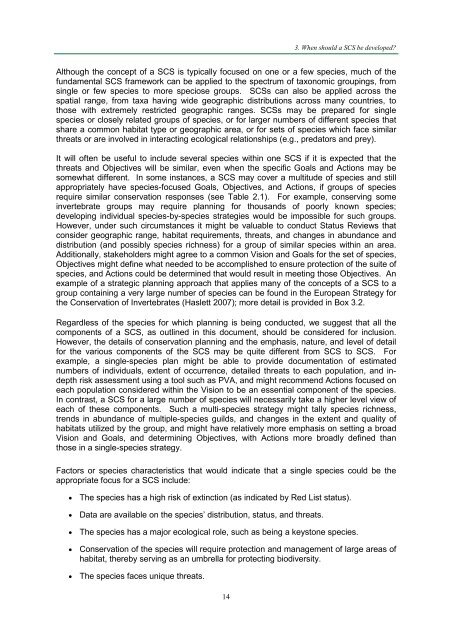Strategic Planning for Species Conservation: A Handbook - IUCN
Strategic Planning for Species Conservation: A Handbook - IUCN
Strategic Planning for Species Conservation: A Handbook - IUCN
You also want an ePaper? Increase the reach of your titles
YUMPU automatically turns print PDFs into web optimized ePapers that Google loves.
14<br />
3. When should a SCS be developed?<br />
Although the concept of a SCS is typically focused on one or a few species, much of the<br />
fundamental SCS framework can be applied to the spectrum of taxonomic groupings, from<br />
single or few species to more speciose groups. SCSs can also be applied across the<br />
spatial range, from taxa having wide geographic distributions across many countries, to<br />
those with extremely restricted geographic ranges. SCSs may be prepared <strong>for</strong> single<br />
species or closely related groups of species, or <strong>for</strong> larger numbers of different species that<br />
share a common habitat type or geographic area, or <strong>for</strong> sets of species which face similar<br />
threats or are involved in interacting ecological relationships (e.g., predators and prey).<br />
It will often be useful to include several species within one SCS if it is expected that the<br />
threats and Objectives will be similar, even when the specific Goals and Actions may be<br />
somewhat different. In some instances, a SCS may cover a multitude of species and still<br />
appropriately have species-focused Goals, Objectives, and Actions, if groups of species<br />
require similar conservation responses (see Table 2.1). For example, conserving some<br />
invertebrate groups may require planning <strong>for</strong> thousands of poorly known species;<br />
developing individual species-by-species strategies would be impossible <strong>for</strong> such groups.<br />
However, under such circumstances it might be valuable to conduct Status Reviews that<br />
consider geographic range, habitat requirements, threats, and changes in abundance and<br />
distribution (and possibly species richness) <strong>for</strong> a group of similar species within an area.<br />
Additionally, stakeholders might agree to a common Vision and Goals <strong>for</strong> the set of species,<br />
Objectives might define what needed to be accomplished to ensure protection of the suite of<br />
species, and Actions could be determined that would result in meeting those Objectives. An<br />
example of a strategic planning approach that applies many of the concepts of a SCS to a<br />
group containing a very large number of species can be found in the European Strategy <strong>for</strong><br />
the <strong>Conservation</strong> of Invertebrates (Haslett 2007); more detail is provided in Box 3.2.<br />
Regardless of the species <strong>for</strong> which planning is being conducted, we suggest that all the<br />
components of a SCS, as outlined in this document, should be considered <strong>for</strong> inclusion.<br />
However, the details of conservation planning and the emphasis, nature, and level of detail<br />
<strong>for</strong> the various components of the SCS may be quite different from SCS to SCS. For<br />
example, a single-species plan might be able to provide documentation of estimated<br />
numbers of individuals, extent of occurrence, detailed threats to each population, and indepth<br />
risk assessment using a tool such as PVA, and might recommend Actions focused on<br />
each population considered within the Vision to be an essential component of the species.<br />
In contrast, a SCS <strong>for</strong> a large number of species will necessarily take a higher level view of<br />
each of these components. Such a multi-species strategy might tally species richness,<br />
trends in abundance of multiple-species guilds, and changes in the extent and quality of<br />
habitats utilized by the group, and might have relatively more emphasis on setting a broad<br />
Vision and Goals, and determining Objectives, with Actions more broadly defined than<br />
those in a single-species strategy.<br />
Factors or species characteristics that would indicate that a single species could be the<br />
appropriate focus <strong>for</strong> a SCS include:<br />
• The species has a high risk of extinction (as indicated by Red List status).<br />
• Data are available on the species’ distribution, status, and threats.<br />
• The species has a major ecological role, such as being a keystone species.<br />
• <strong>Conservation</strong> of the species will require protection and management of large areas of<br />
habitat, thereby serving as an umbrella <strong>for</strong> protecting biodiversity.<br />
• The species faces unique threats.

















